


C57BL/6-Tgfbr2tm3(TGFBR2)Bcgen Pdgfratm2(PDGFRA)Bcgen/Bcgen • 112766
| Product name | B-hTGFBR2/hPDGFRA mice |
|---|---|
| Catalog number | 112766 |
| Strain name | C57BL/6-Tgfbr2tm3(TGFBR2)Bcgen Pdgfratm2(PDGFRA)Bcgen/Bcgen |
| Strain background | C57BL/6 |
| NCBI gene ID | 7048, 5156 |
| Aliases | AAT3, FAA3, LDS2, MFS2, RIIC, LDS1B, LDS2B, TAAD2, TBRII, TBR-ii, TGFR-2, TGFbeta-RII; CD140A, PDGFR2, PDGFR-2 |
| Application | For example, this product is used for pharmacodynamics and safety evaluation of anti-TGFBR2 and PDGFRA antibodies for cancers. |
Gene targeting strategy for B-hTGFBR2/hPDGFRA mice. A chimeric CDS that encodes mouse TGFBR2 signal peptide and human extracellular domain, mouse Tgfbr2 transmembrane and cytoplasmic domain, followed by mouse 3’UTR-STOP is inserted right after the exon 2 of mouse Tgfbr2 gene. The chimeric TGFBR2 protein expression will be driven by endogenous mouse Tgfbr2 promoter, while mouse Tgfbr2 gene transcription and translation will be disrupted. The exons 3-11 of mouse Pdgfra gene that encode signal peptide and extracellular domain is replaced by human counterparts in B-hTGFBR2/hPDGFRA mice. The genomic region of mouse Pdgfra gene that encodes cytoplasmic portion is retained. The promoter, 5’UTR and 3’UTR region of the mouse gene are also retained. The chimeric PDGFRA expression is driven by endogenous mouse Pdgfra promoter, while mouse Pdgfra gene transcription and translation will be disrupted.

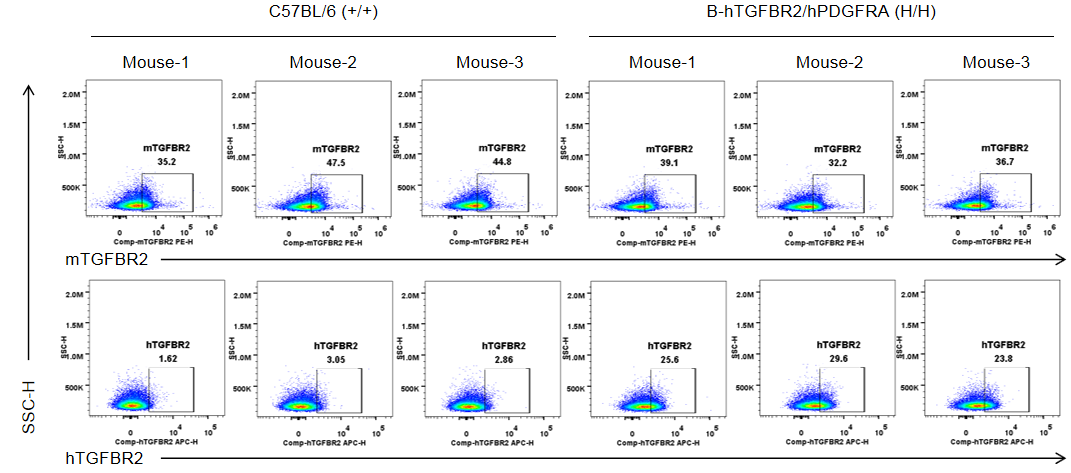
Strain specific TGFBR2 expression analysis in homozygous B-hTGFBR2/hPDGFRA mice(H/H) by flow cytometry. Splenocytes were collected from wild-type C57BL/6 mice(+/+) and homozygous B-hTGFBR2/hPDGFRA mice(H/H). Mouse TGFBR2 was detectable in C57BL/6 mice(+/+) and homozygous B-hTGFBR2/hPDGFRA mice(H/H) using anti-mouse TGFBR2 antibody(R&D, FAB532P), as the antibody is cross-recognized between human and mouse TGFBR2. Human TGFBR2 was exclusively detectable in T cells of homozygous B-hTGFBR2/hPDGFRA mice(H/H) using anti-human TGFBR2 antibody.
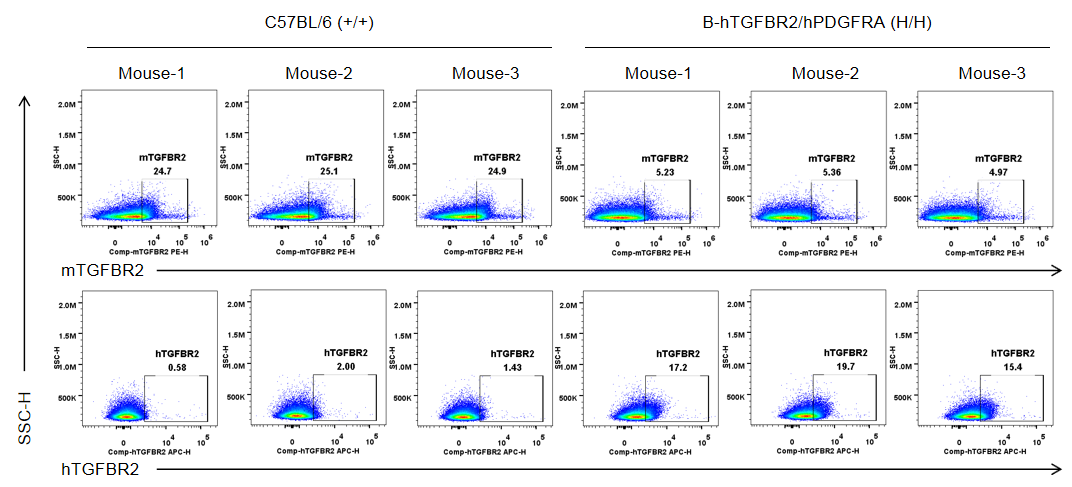
Strain specific TGFBR2 expression analysis in homozygous B-hTGFBR2/hPDGFRA mice(H/H) by flow cytometry. Splenocytes were collected from wild-type C57BL/6 mice(+/+) and homozygous B-hTGFBR2/hPDGFRA mice(H/H). Mouse TGFBR2 was detectable in C57BL/6 mice(+/+) and homozygous B-hTGFBR2/hPDGFRA mice(H/H) using anti-mouse TGFBR2 antibody(R&D, FAB532P), as the antibody is cross-recognized between human and mouse TGFBR2. Human TGFBR2 was exclusively detectable in B cells of homozygous B-hTGFBR2/hPDGFRA mice(H/H) using anti-human TGFBR2 antibody.
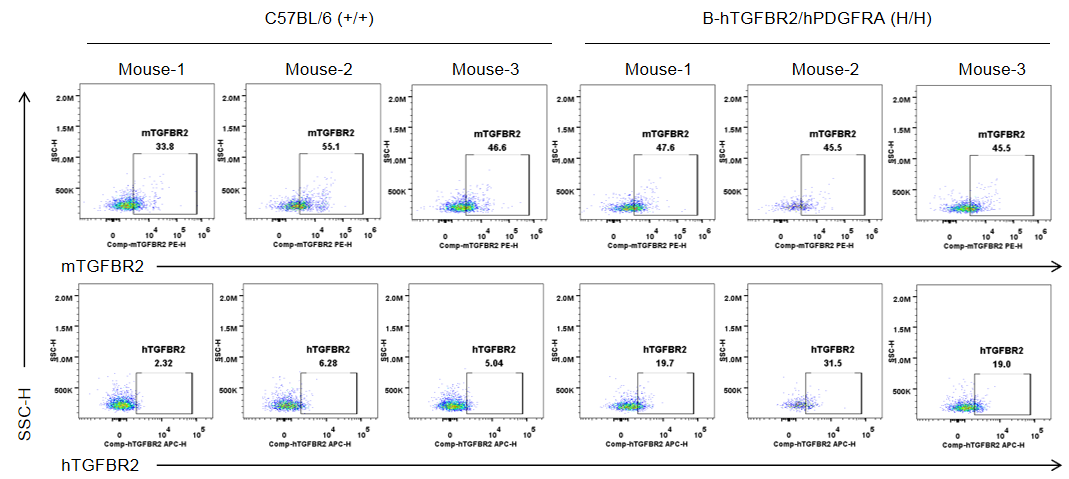
Strain specific TGFBR2 expression analysis in homozygous B-hTGFBR2/hPDGFRA mice(H/H) by flow cytometry. Splenocytes were collected from wild-type C57BL/6 mice(+/+) and homozygous B-hTGFBR2/hPDGFRA mice(H/H). Mouse TGFBR2 was detectable in C57BL/6 mice(+/+) and homozygous B-hTGFBR2/hPDGFRA mice(H/H) using anti-mouse TGFBR2 antibody(R&D, FAB532P), as the antibody is cross-recognized between human and mouse TGFBR2. Human TGFBR2 was exclusively detectable in NK cells of homozygous B-hTGFBR2/hPDGFRA mice(H/H) using anti-human TGFBR2 antibody.
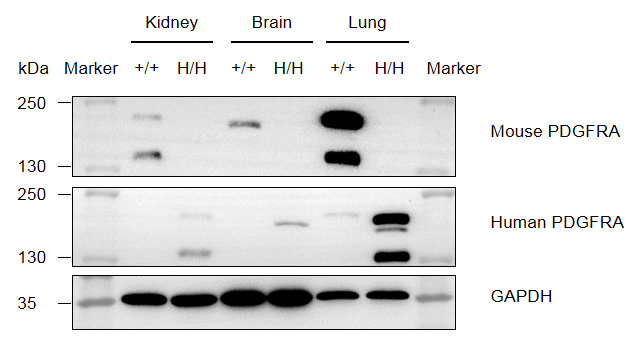
Strain specific PDGFRA expression analysis in homozygous B-hTGFBR2/hPDGFRA mice by Western Blot. Kidney, brain and lung tissues were were collected from wild-type C57BL/6 mice(+/+) and homozygous B-hTGFBR2/hPDGFRA mice(H/H), and then analyzed by western blot with anti-mouse PDFGRA antibody and anti-human PDFGRA antibody. Mouse PDGFRA was exclusively detected in kidney, brain and lung of wild-type mice. Human PDGFRA was exclusively detected in kidney, brain and lung of homozygous B-hTGFBR2/hPDGFRA mice.
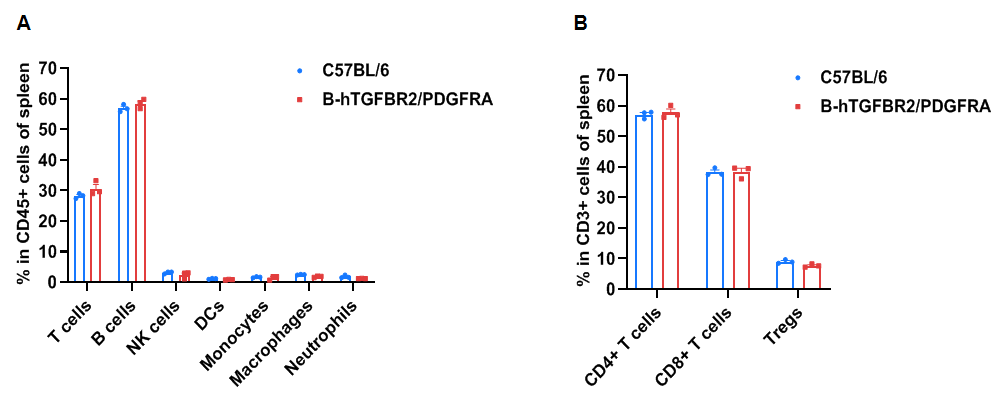
Frequency of leukocyte subpopulations in spleen by flow cytometry. Splenocytes were isolated from wild-type C57BL/6 mice and homozygous B-hTGFBR2/hPDGFRA mice (n=3, 7-week-old). A. Flow cytometry analysis of the splenocytes was performed to assess the frequency of leukocyte subpopulations. B. Frequency of T cell subpopulations. Percentages of T cells, B cells, NK cells, dendritic cells, monocytes, macrophages, neutrophils, CD4+ T cells, CD8+ T cells and tregs in B-hTGFBR2/hPDGFRA mice were similar to those in C57BL/6 mice, demonstrating that humanization of TGFBR2 and PDGFRA does not change the frequency or distribution of these cell types in spleen. Values are expressed as mean ± SEM. Significance was determined by two-way ANOVA test. *P < 0.05, **P < 0.01, ***P < 0.001.